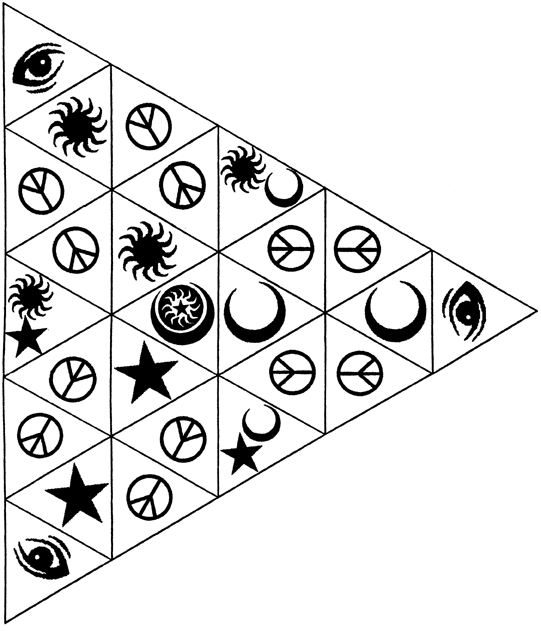
EQUIPMENT
Trice is a game for 3 players that uses Icehouse pieces and a small, triangular gameboard that is shown below. (You will need to print this out and perhaps even copy it onto cardstock in order to play this game.)

This game also uses dice. A set of 3 four-sided dice is recommended; however, if these are unavailable, the game can also be played with a pair of regular six-sided dice.
RULES
The object of the game is to occupy all of the spaces on the board that contain a specific mystic symbol. The 3 symbols are the sun, the moon, and the star. For each of these symbols, there are 5 spaces on the board that must be occupied in order to win. Two of these spaces contain only the one symbol, two are shared with one other symbol (these are called Bi-Spaces), and the final space contains all 3 symbols. (This space is the center space on the board, and it is called the Tri-Space.)
The board is empty at the start of the game.
Roll the dice to determine who goes first.
On your turn, roll the dice to determine your number of movement points for that turn. It costs 3 movement points to move a large piece from one space to another, 2 movement points for a medium sized piece, and 1 movement point for a small piece. During your turn, you may move any number of pieces you wish, and may move across as many spaces as your movement point total will allow. (You are not required to make use of all of your movement points.)
At any time during your turn, you may place a new piece on the board (at the space with the eye) by spending movement points according to the size of the piece. In other words, you can move a piece onto the board (at the Eye Space) in the same way that you move pieces between the spaces on the board.
You may load the Eye Space at no cost, once per turn, with any size piece. This is called a Free Load.
There can be only one piece on a given space of the board at one time. When one piece is moved into an occupied space, there are three cases, as follows:
Pieces may only move from one space to another across the line where two triangle sides meet.
A piece may not move into a spot already occupied by any piece of that same color.
A piece may not move into a Bi-Space unless there are at least 4 pieces of that color in play.
A piece may not move into the Tri-Space unless 2 Bi-Spaces are held by that same color.
The player who occupies the Tri-Space has a special power, called the Nuclear Option. This player may, at the start of his or her turn, freely remove a piece (or pieces) from the board, according to the following conditions:
The player who holds the Tri-Space may choose to nuke one of his or her own pieces.
The player who holds the Tri-Space may roll the dice for movement before deciding what they wish to nuke.
If another player has a piece on your Eye Space at the start of your turn, you must eject that piece from the Eye Space when you bring a new piece onto the board. This means that a small piece cannot be brought onto the board if a medium or large piece is on the Eye Space. Furthermore, if a large piece is on the Eye Space, you must load with a large piece of your own (and suffer the resulting reduction in size) in order to unclog your Eye Space.
There is no need to occupy the goal spaces for any length of time. The game ends as soon as someone has a piece in all 5 goal spaces. That player is the winner.
SUMMARY OF TERMS
Goal symbols: The sun, moon, and star. To win, a player must occupy all of the 5 spaces that contain a particular goal symbol (for example, all 5 stars or all 5 moons).
Bi-Space: One of the spaces that contain two of the three goal symbols. These spaces can only be entered by a player who has at least 4 pieces in play.
Tri-Space: The center spot, which contains all three goal symbols. This space can only be entered by a player who occupies two Bi-Spaces.
Eye Space: One of the spaces with an eye. New pieces can only enter the game at these points.
Free Load: Placing a new piece on the Eye Space without expending any movement points.
Nuclear Option: The power of the player who controls the Tri-Space to remove any piece from the board.
Peace Space: One of the spaces with a peace symbol. These spaces offer protection from the Nuclear Option.